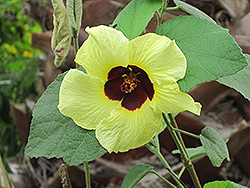It's all about ...
plants

Height: 7 feet
Spread: 4 feet
Sunlight:
![]()
![]()
Hardiness Zone: 8a
Other Names: Cream Hibiscus
Description:
This small bushy shrub features showy yellow-cream blooms with contrasting burgundy-red centers; flowers on and off for much of the year in warm climates; ideal for the mixed garden border or massed; do not allow to dry to wilting point
Ornamental Features
Formosan Hibiscus features bold buttery yellow round flowers with creamy white overtones and burgundy centers at the ends of the branches from early spring to mid fall. It has green deciduous foliage. The large serrated heart-shaped leaves do not develop any appreciable fall colour.
Landscape Attributes
Formosan Hibiscus is a multi-stemmed deciduous shrub with an upright spreading habit of growth. Its relatively coarse texture can be used to stand it apart from other landscape plants with finer foliage.
This shrub will require occasional maintenance and upkeep, and is best pruned in late winter once the threat of extreme cold has passed. It is a good choice for attracting butterflies and hummingbirds to your yard. Gardeners should be aware of the following characteristic(s) that may warrant special consideration;
- Insects
- Self-Seeding
Formosan Hibiscus is recommended for the following landscape applications;
- Accent
- Mass Planting
- General Garden Use
- Naturalizing And Woodland Gardens
Planting & Growing
Formosan Hibiscus will grow to be about 7 feet tall at maturity, with a spread of 4 feet. It has a low canopy, and is suitable for planting under power lines. It grows at a fast rate, and under ideal conditions can be expected to live for approximately 5 years.
This shrub does best in full sun to partial shade. It is quite adaptable, prefering to grow in average to wet conditions, and will even tolerate some standing water. It is not particular as to soil pH, but grows best in rich soils. It is highly tolerant of urban pollution and will even thrive in inner city environments. Consider applying a thick mulch around the root zone in winter to protect it in exposed locations or colder microclimates. This species is not originally from North America.
This plant is not reliably hardy in our region, and certain restrictions may apply; contact the store for more information.
